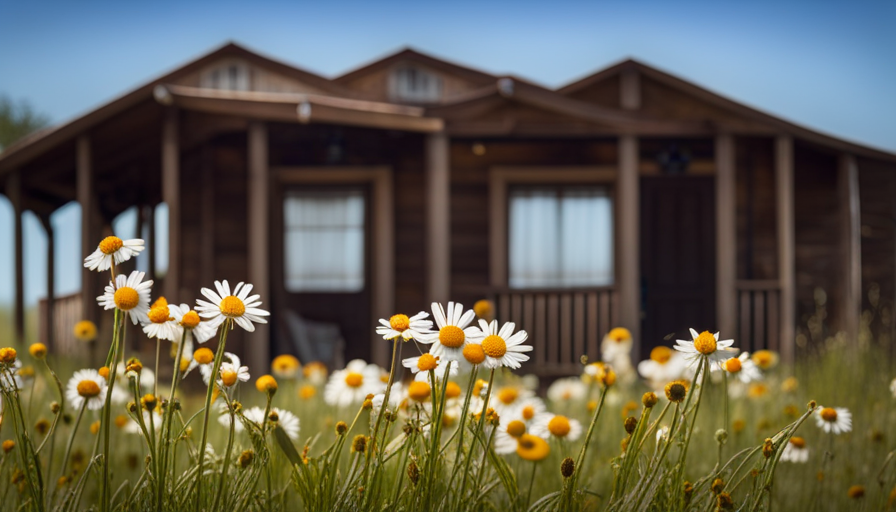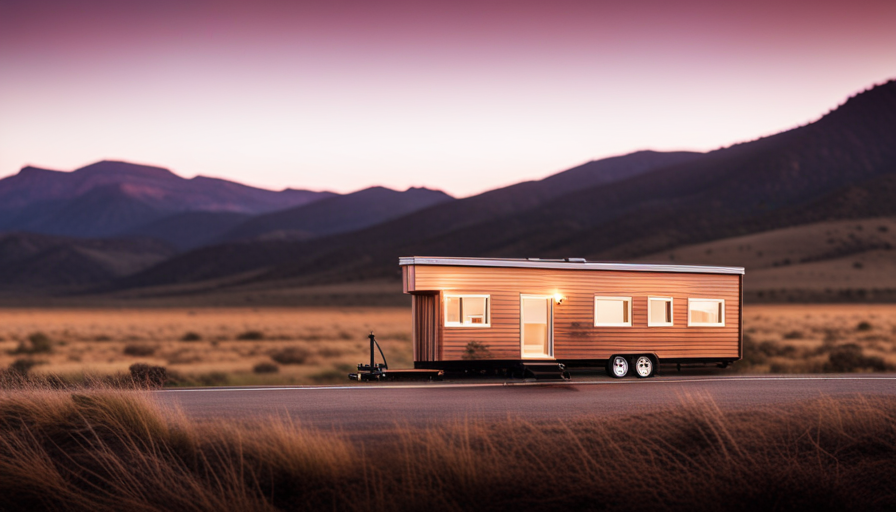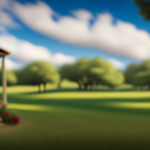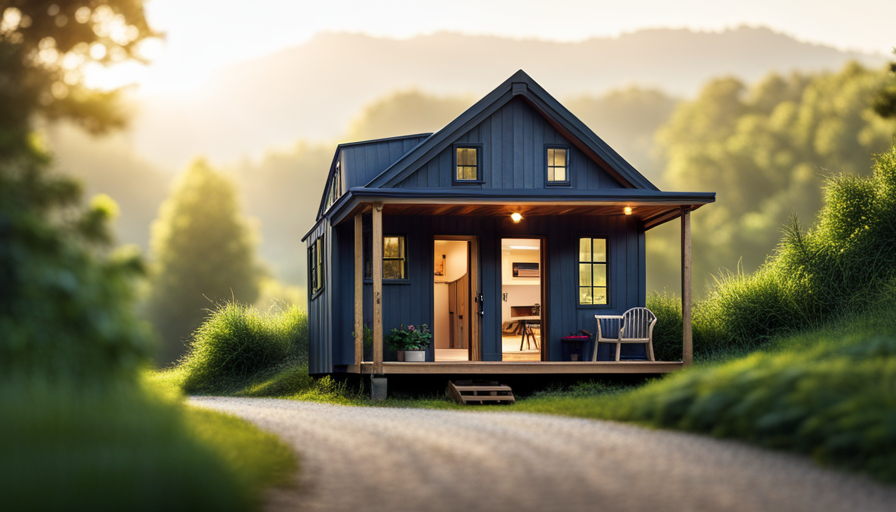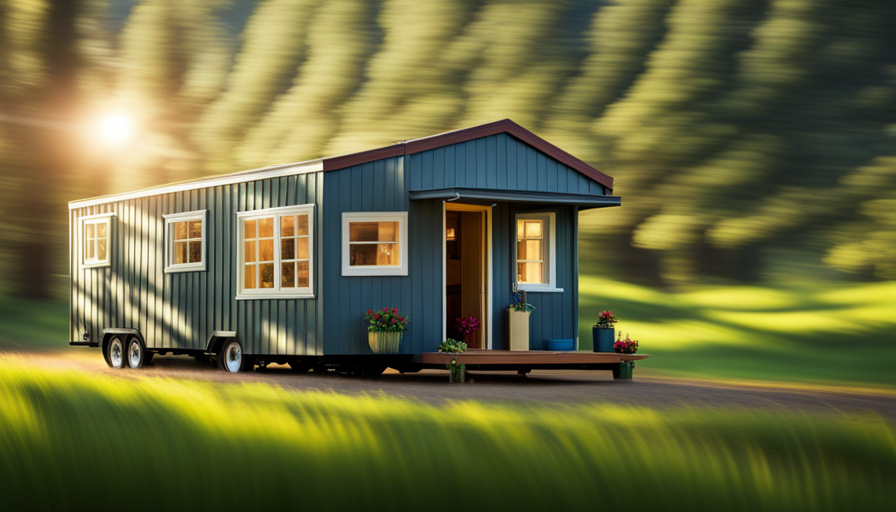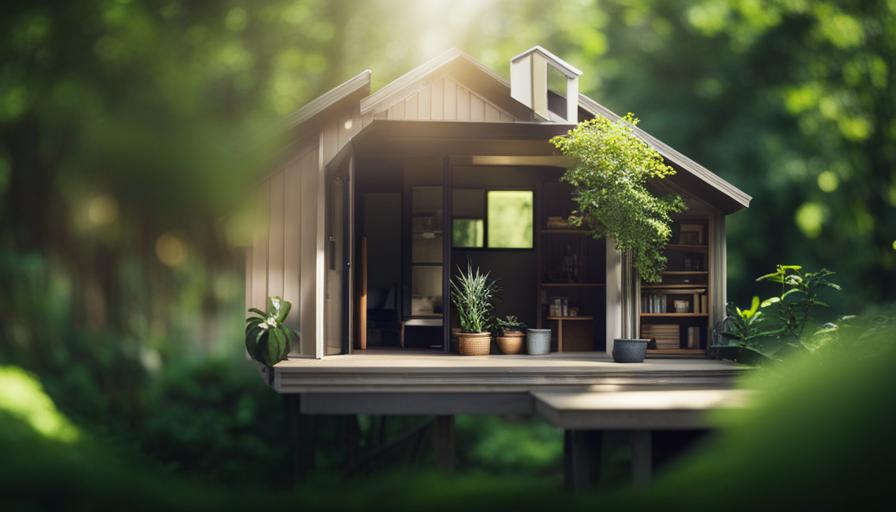I was recently researching the prices of small homes in Texas, and I have to admit, the options available are really intriguing.
Living in a tiny house has become a popular trend, especially in a state like Texas where the vast landscapes and affordable living opportunities abound. As I delved into the subject, I discovered several factors that influence the cost of these pint-sized dwellings, ranging from location to size and amenities.
In this article, I will delve into the average price range for tiny houses in Texas, explore some affordable options, discuss financing and payment options, and provide tips on finding and buying a tiny house in the Lone Star State. Additionally, I will delve into the pros and cons of living in a tiny house and explore alternative housing options for those seeking a unique living experience in Texas.
So, if you’re curious about the cost of a tiny house in Texas, you’ve come to the right place. Let’s get started!
Key Takeaways
- The cost of a tiny house in Texas can vary depending on factors such as customization options, size, and location, with the average price range being $30,000 – $60,000.
- Texas offers a variety of affordable housing options, including pre-built houses, DIY kits, and tiny house communities, with financing options available such as upfront payment, loans, and rent-to-own.
- It is important to consider factors such as location, zoning regulations, and popular locations when buying a tiny house in Texas, as prices can range from $60,000 – $200,000 in cities like Austin, Dallas, Houston, and San Antonio.
- It is recommended to research reputable tiny house builders in the area and familiarize oneself with zoning regulations, which can be done by contacting local offices and joining online communities and forums.
Factors Influencing the Cost of Tiny Houses in Texas
If you’re looking to buy a tiny house in Texas, you’ll be amazed at how various factors can greatly impact the cost, making it an exciting and sometimes challenging journey to find your perfect affordable home.
One of the main factors that influence the cost of tiny houses in Texas is the level of customization options you choose. The more customized your tiny house is, the higher the price will be. This is because customization requires additional materials, labor, and design expertise, which all add up.
Another factor that affects the cost of tiny houses in Texas is the size of the house itself. Typically, the larger the tiny house, the higher the cost. However, it’s important to note that even though tiny houses are small by nature, they can still vary in size, ranging from around 100 to 400 square feet.
Additionally, the location of the tiny house can also influence its cost. If you choose to place your tiny house in a prime location or a highly desirable area, the cost may be higher due to the increased demand and property values.
Considering these factors, it’s crucial to carefully consider your budget and priorities when searching for a tiny house in Texas. Now, let’s delve into the average price range for tiny houses in Texas, where we’ll explore the different options available and help you find the perfect tiny house that fits your budget.
Average Price Range for Tiny Houses in Texas
On average, you can expect to pay a modest sum for a compact dwelling in the Lone Star State. The average price range for tiny houses in Texas falls between $30,000 and $60,000.
However, it’s important to note that this range can vary depending on various factors such as size, location, and amenities. Larger tiny houses with more luxurious features can command higher prices, while smaller and simpler models tend to be more affordable.
When considering the cost of a tiny house in Texas, it’s also worth exploring the options for affordable financing. Many tiny house builders in the state offer financing plans to help make the dream of owning a tiny house more attainable. These plans may include low down payments, favorable interest rates, and flexible repayment terms.
Furthermore, Texas is home to a thriving community of tiny house builders who specialize in creating affordable and high-quality dwellings. These builders are experienced in designing and constructing tiny houses that maximize space and functionality while keeping costs reasonable.
In the subsequent section about affordable tiny house options in Texas, we’ll delve deeper into the various choices available for those looking to embrace the tiny house lifestyle without breaking the bank.
Affordable Tiny House Options in Texas
There are numerous affordable options for those looking to embrace the tiny house lifestyle in Texas, with prices ranging from $20,000 to $40,000, making it an accessible choice for many individuals and families. Texas offers a wide selection of tiny houses at affordable pricing, ensuring that there is something for everyone’s budget.
Whether you’re a minimalist seeking a simpler way of life or a family looking to downsize and reduce expenses, Texas has a variety of available options to suit your needs.
One option is to purchase a pre-built tiny house from a reputable manufacturer. These houses often come with basic amenities and are ready for immediate occupancy.
Another option is to build your own tiny house. DIY kits are available at affordable prices, allowing you to customize and personalize your living space while saving money.
Additionally, there are tiny house communities in Texas that offer affordable housing options. These communities provide a sense of community and shared resources, making the tiny house lifestyle even more affordable.
When it comes to financing and payment options for tiny houses in Texas, there are various options available. Some individuals choose to finance their tiny houses through traditional loans, while others opt for alternative financing methods such as personal loans or crowdfunding.
Additionally, some tiny house manufacturers offer in-house financing options, making it easier for individuals to purchase their dream tiny home.
With the availability of affordable pricing and various financing options, embracing the tiny house lifestyle in Texas has never been more attainable.
Moving forward, let’s explore the financing and payment options for tiny houses in Texas.
Financing and Payment Options for Tiny Houses in Texas
With a variety of financing options available, Texans can easily turn their dreams of owning a cozy and affordable home into a reality. When it comes to financing a tiny house in Texas, there are several payment plans to consider. Whether you choose to pay upfront, take out a loan, or explore rent-to-own options, there is a solution that can fit your budget and lifestyle.
To help you navigate through the various financing options, here is a table outlining some of the most common choices:
| Financing Option | Description | Pros | Cons |
|---|---|---|---|
| Paying Upfront | Paying the full price of the tiny house upfront. | No interest or monthly payments. | Requires a significant amount of savings. |
| Tiny House Loans | Taking out a loan from a financial institution. | Allows for gradual payments over time. | Interest rates may be higher than traditional mortgages. |
| Rent-to-Own | Renting the tiny house with an option to purchase it in the future. | Low initial costs. | Limited selection of available tiny houses. |
Considering the financing options available, it’s important to also consider other factors when buying a tiny house in Texas, such as location, size, and mobility. By thoroughly evaluating these considerations, you can make an informed decision that aligns with your needs and preferences.
Considerations When Buying a Tiny House in Texas
When considering purchasing a tiny home in the Lone Star State, it’s essential to envision the perfect blend of charm, functionality, and affordability. Texas offers a variety of financing options for those looking to buy a tiny house. From traditional mortgages to personal loans, there are options available to fit different financial situations. It’s important to research and compare these options to find the best fit for your needs.
Additionally, it’s crucial to consider the zoning regulations in Texas before purchasing a tiny house. Each city and county may have different regulations regarding where you can park or build a tiny house. It’s important to ensure that the location you choose is in compliance with these regulations to avoid any potential legal issues.
When it comes to popular locations for tiny house living in Texas, there are plenty of options to choose from. From vibrant cities like Austin and Dallas to scenic areas like the Hill Country and Gulf Coast, Texas offers a wide range of environments to suit different preferences. Transitioning into the subsequent section about popular locations for tiny house living in Texas, it’s important to explore the different options available to find the perfect spot for your tiny home.
Popular Locations for Tiny House Living in Texas
Looking for the perfect spot to park your tiny home in the Lone Star State? Well, let’s explore some popular locations in Texas that are bound to capture your heart! Texas offers a wide range of options for tiny house living, from bustling urban areas to serene countryside settings. Here are some popular locations and their average price ranges:
| Location | Average Price Range |
|---|---|
| Austin | $100,000 – $200,000 |
| Dallas | $80,000 – $150,000 |
| Houston | $70,000 – $120,000 |
| San Antonio | $60,000 – $100,000 |
Austin, the state capital, is known for its vibrant music scene and eclectic culture. With an average price range of $100,000 to $200,000, it offers a mix of urban amenities and natural beauty. Dallas, a major metropolitan area, has an average price range of $80,000 to $150,000. It boasts a thriving arts district and a bustling downtown. Houston, the largest city in Texas, offers a diverse range of tiny house options with an average price range of $70,000 to $120,000. San Antonio, known for its rich history and vibrant riverwalk, has an average price range of $60,000 to $100,000.
Now that you know about some popular locations, let’s dive into tips for finding and buying a tiny house in Texas.
Tips for Finding and Buying a Tiny House in Texas
Ready to embark on your journey to find and purchase the perfect little slice of Texas living? When it comes to finding and buying a tiny house in Texas, there are a few key things to keep in mind.
First and foremost, you’ll need to find reputable tiny house builders in the area. Do your research, read reviews, and ask for recommendations from others who’ve gone through the process.
Next, it’s important to familiarize yourself with the zoning regulations for tiny houses in Texas. Each city and county may have different rules and restrictions, so make sure you’re aware of what’s allowed in your desired location.
In addition to these important considerations, here are a couple of sub-lists to help you navigate the process of finding and buying a tiny house in Texas:
-
Tips for finding a tiny house builder:
- Research different builders and their portfolios
- Visit tiny house communities or events to see their work in person
-
Tips for understanding zoning regulations:
- Contact local zoning offices for information on specific regulations
- Join online communities or forums to connect with others who’ve navigated the zoning process
Finding and buying a tiny house in Texas can be an exciting and rewarding experience. Once you’ve done your research and are familiar with the builders and zoning regulations, you’ll be well-prepared to make an informed decision.
Now, let’s explore the pros and cons of living in a tiny house in Texas.
Pros and Cons of Living in a Tiny House in Texas
Although there are both advantages and disadvantages to residing in a compact dwelling in the Lone Star State, the decision to live in a tiny house in Texas ultimately depends on individual preferences and lifestyle choices. Downsizing to a tiny house offers several benefits, such as reduced expenses and a smaller carbon footprint. With lower mortgage or rental costs, homeowners can save money and have more financial freedom. Additionally, living in a small space encourages minimalism and decluttering, leading to a simpler and less stressful lifestyle. However, there are also challenges to consider. One major obstacle is the zoning regulations for tiny houses in Texas. Many cities have restrictions on where these homes can be located, making it difficult to find suitable land. Furthermore, the limited space in a tiny house can pose challenges for storage and privacy. Despite these drawbacks, the tiny house movement continues to gain popularity in Texas, as it provides an affordable housing option for those looking to simplify their lives. In the next section, we will explore alternative housing options in Texas that can also meet the needs of individuals seeking a unique and cost-effective living situation.
Alternative Housing Options in Texas
When considering alternative housing options in Texas, there are several choices to explore.
One option is RV living, which offers the flexibility of being able to travel while still having a home base.
Container homes are another popular choice, as they’re affordable and eco-friendly.
Additionally, yurts and tiny cabins provide a unique and minimalist lifestyle, perfect for those seeking a simpler way of living.
RV Living
Living in an RV can be an affordable option, as you’ll save around 60% on housing expenses compared to traditional living arrangements. RV living offers a mobile lifestyle, allowing you to travel and explore different areas of Texas while still having a place to call home. It provides a sense of freedom and adventure, with the added benefit of reduced maintenance and utility costs.
Many RV parks in Texas offer various amenities such as laundry facilities, swimming pools, and community events, making it a sociable living experience. However, if RV living doesn’t suit your needs, another alternative housing option in Texas is container homes. These homes are made from recycled shipping containers and can be customized to fit your preferences. They provide a unique and eco-friendly housing solution and can be more cost-effective than traditional homes.
Container Homes
After exploring the world of RV living, let’s dive into another fascinating alternative housing option: container homes. These unique dwellings have gained popularity in recent years, offering a modern and eco-friendly twist to traditional homes.
Container homes are made from shipping containers that are repurposed into living spaces. They provide a cost-effective solution for those seeking affordability and sustainability. In Texas, container homes can range in price from $20,000 for a basic setup to $150,000 for a more luxurious design. The cost varies depending on factors such as size, customization, and location.
With their modular design, container homes offer flexibility and can be easily transported or expanded.
Now, let’s transition into the next section where we’ll explore the enchanting world of yurts and tiny cabins.
Yurts and Tiny Cabins
Yurts and tiny cabins offer a charming escape, inviting individuals to immerse themselves in the simplicity and tranquility of nature.
Yurts, originally used by nomadic tribes, have become popular options for those seeking a unique and eco-friendly living space. These circular structures feature a lattice framework covered with fabric, providing a cozy and spacious interior. Yurts are often constructed using sustainable materials such as bamboo or reclaimed wood, making them environmentally friendly.
On the other hand, tiny cabins are small, rustic dwellings that blend seamlessly into natural surroundings. These cabins are typically built with minimal impact on the environment, using sustainable construction methods and materials. They offer a cozy retreat and can be customized to fit the needs and preferences of the owner.
From yurts to tiny cabins, there are various options available for those who desire a simpler way of living close to nature. When searching for a tiny house in Texas, there are several resources and websites that can help you find the perfect home.
Resources and Websites for Finding Tiny Houses in Texas
When searching for tiny houses in Texas, you can easily find various resources and websites that provide listings and information. These resources are helpful in finding the perfect tiny house that fits your needs and preferences. In addition to listings, these websites often offer valuable information on financing options and tiny house communities in Texas.
One popular website for finding tiny houses in Texas is "Tiny House Listings." This website allows you to search for tiny houses by location, size, and price range. It also provides a platform for sellers to list their tiny houses for sale. Another useful resource is "Tiny House Finder." This website offers a comprehensive directory of tiny house builders, communities, and events in Texas.
If you’re looking for financing options, "Tiny House Loans" is a great website to explore. It provides information on loans specifically designed for purchasing or building a tiny house. They offer resources and guidance on securing financing and understanding the loan process.
Overall, these resources and websites make it easier to find and navigate the world of tiny houses in Texas. Whether you’re interested in purchasing a tiny house or joining a tiny house community, these platforms are valuable tools to help you make informed decisions.
Frequently Asked Questions
Are there any specific zoning regulations or restrictions for tiny houses in Texas?
In Texas, there are specific zoning regulations and building codes that apply to tiny houses. These regulations vary depending on the location within the state.
Zoning regulations determine where tiny houses can be placed, such as in residential or mixed-use areas.
Building codes ensure that tiny houses meet safety and structural requirements.
It’s important to research and comply with these regulations before building or placing a tiny house in Texas to avoid any legal issues or penalties.
What are the maintenance costs associated with owning a tiny house in Texas?
Maintenance costs for a tiny house in Texas can vary depending on factors like size, materials used, and location. Generally, there are both pros and cons to consider.
On the positive side, tiny houses require less maintenance overall compared to larger homes. However, certain aspects like plumbing or electrical systems may need regular upkeep. Additionally, it’s important to budget for routine maintenance tasks such as painting, roof repairs, and pest control.
Overall, the maintenance costs of owning a tiny house in Texas can be manageable with proper planning and budgeting.
Can I customize the design and layout of a tiny house in Texas?
Absolutely! When it comes to building a tiny house in Texas, you have plenty of customization options and design flexibility. From choosing the layout and materials to adding unique features, the possibilities are endless. Whether you want a cozy rustic cabin or a sleek modern design, you can create a tiny house that reflects your personal style and needs.
The freedom to customize is one of the many advantages of owning a tiny house in Texas.
Are there any tax benefits or incentives for owning a tiny house in Texas?
There are indeed tax benefits and financial incentives for owning a tiny house in Texas. As a tiny house owner, you may be eligible for certain tax deductions. For example, you could potentially deduct the mortgage interest on your tiny house if it meets certain criteria.
Additionally, there may be financial incentives available, such as grants or programs aimed at promoting environmentally friendly housing options. These incentives can help offset the costs of owning and maintaining a tiny house.
Are there any specific insurance requirements for tiny houses in Texas?
Insurance coverage for tiny houses in Texas may vary depending on factors such as the size, location, and intended use of the house. It’s important to check with insurance providers to ensure adequate coverage.
Additionally, building codes play a crucial role in determining insurance requirements. Complying with local building codes can help in obtaining insurance and protecting against potential risks.
It’s advisable to consult with professionals to understand the specific insurance requirements for tiny houses in Texas.
Conclusion
In conclusion, the world of tiny houses in Texas is as vast as the Lone Star State itself. These small yet mighty abodes offer an alternative housing option that can fit a variety of budgets and lifestyles.
Like a wildflower blooming in a field, tiny houses have the power to bring simplicity, freedom, and a sense of adventure to those who choose to embrace them. So, whether you’re searching for a cozy retreat or a sustainable living solution, the tiny house market in Texas has something for everyone.
Explore, dream, and find your own little piece of paradise in the land where everything is bigger, but sometimes, smaller is better.
Hi, I’m Emma. I’m the Editor in Chief of Tiny House 43, a blog all about tiny houses. While tree houses are often associated with childhood, they can be the perfect adult retreat. They offer a cozy space to relax and unwind, surrounded by nature. And since they’re typically built on stilts or raised platforms, they offer stunning views that traditional homes simply can’t match. If you’re looking for a unique and romantic getaway, a tree house tiny house might just be the perfect option.
